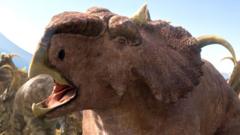
The Mystery of Pipestone Creek: Unraveling a Dinosaurian Mass Grave
A Canadian Enigma Unearths Ancient Secrets
Pipestone Creek, a seemingly unassuming locale in Alberta, Canada, holds a secret buried deep beneath its surface: a vast accumulation of dinosaur remains, a veritable graveyard of prehistoric proportions. For years, paleontologists have been drawn to this site, compelled to unravel the mystery of how thousands of these magnificent creatures came to be entombed in a single location.
The area, known as the Pipestone Creek bonebed, primarily contains the remains of Pachyrhinosaurus lakustai, a large, horned dinosaur that roamed the Earth during the Late Cretaceous period, approximately 73 million years ago. The sheer density of bones – estimates suggest thousands of individual dinosaurs are represented – distinguishes Pipestone Creek from other fossil sites around the globe.
Theories and Investigations: Piecing Together the Past
The presence of such a large concentration of dinosaur remains naturally begs the question: what catastrophic event could have led to this mass mortality? Several hypotheses have been proposed, each attempting to explain the circumstances surrounding the dinosaurs' demise and subsequent burial.
- The Flood Hypothesis: One prominent theory suggests that a catastrophic flood event overwhelmed a large herd of Pachyrhinosaurus. The rushing waters could have swept the dinosaurs into a natural depression or body of water, where they perished and were rapidly buried under layers of sediment. The presence of fine-grained silt and clay surrounding the bones lends credence to this idea.
- Disease and Weakness: Another possibility is that a disease outbreak weakened a large segment of the Pachyrhinosaurus population. The weakened animals may have congregated near a water source, seeking relief, only to succumb to their illness and perish en masse. This theory is more difficult to prove directly from the fossil record but remains a viable consideration.
- Drought and Desiccation: Alternatively, a prolonged period of drought could have concentrated the Pachyrhinosaurus population around dwindling water sources. As the drought intensified, the animals may have become increasingly stressed and susceptible to disease, starvation, or dehydration, ultimately leading to their collective demise.
- Volcanic Activity: Though less directly supported by the geological evidence at Pipestone Creek itself, the possibility of volcanic activity playing a role cannot be entirely discounted. Ashfalls or other volcanic byproducts could have poisoned water sources or otherwise contributed to the dinosaurs' demise.
Ongoing Research: Unearthing New Evidence
Research at Pipestone Creek is ongoing, with paleontologists employing a variety of techniques to gather more information about the dinosaurs and the environment in which they lived. Excavations are carefully conducted, with each bone meticulously documented and cataloged. Microscopic analysis of the surrounding sediment provides clues about the paleoenvironment, including the climate, vegetation, and water conditions present at the time of the dinosaurs' death.
Furthermore, advanced dating techniques are used to refine the age of the bonebed and to correlate it with other geological events that occurred during the Late Cretaceous period. By comparing the fossils found at Pipestone Creek with those discovered at other locations, paleontologists can gain a better understanding of the distribution, behavior, and evolution of Pachyrhinosaurus and other contemporary dinosaur species.
The Significance of Pipestone Creek
The Pipestone Creek bonebed is more than just a collection of dinosaur bones; it is a window into a pivotal moment in Earth's history. The site offers invaluable insights into the lives, deaths, and environments of these magnificent creatures, helping us to better understand the complex interplay between life and environment during the Late Cretaceous period.
The continued research at Pipestone Creek promises to reveal even more secrets in the years to come, further solidifying its place as one of the world's most important dinosaur fossil sites. The mystery of why thousands of Pachyrhinosaurus are buried here may never be completely solved, but each new discovery brings us one step closer to understanding this remarkable chapter in Earth's paleontological history.
Future Directions
Future research at Pipestone Creek will likely focus on the following areas:
- Detailed taphonomic analysis: A more in-depth study of the bonebed's taphonomy (the study of how organisms decay and become fossilized) will help to refine our understanding of the events that led to the dinosaurs' death and burial.
- Paleoenvironmental reconstruction: Further analysis of the sediment surrounding the bones will provide a more detailed picture of the environment in which the dinosaurs lived, including the climate, vegetation, and water sources.
- Comparative anatomy: Comparing the bones found at Pipestone Creek with those of other Pachyrhinosaurus specimens from different locations will shed light on the species' variation and evolution.
- Public outreach and education: Efforts to educate the public about the importance of Pipestone Creek and the research being conducted there will help to foster a greater appreciation for paleontology and the natural world.
